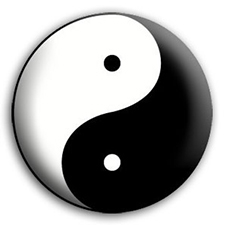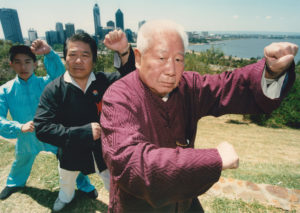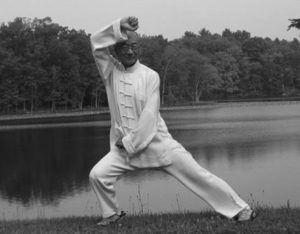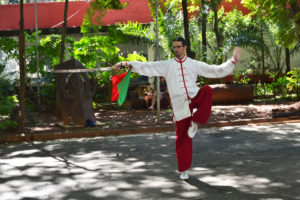Slanted FlyingJournal of Tai Chi Chuan
Training
Taijiquan’s Secondary Energy/Power Techniques
Since we have multiple body parts (multiple spheres), different parts of the body can simultaneously produce energies against a partner/opponent. I view lie (split/tear/rend/wring/snap…) as torque (force applied in differing directions). This is often a push-pull type of energy applied to the partner/opponent. The application can produce forces in opposite directions like an axe splitting wood, like scissors working straight against each other, like wringing a towel, like tearing a piece of paper, like snapping a pencil, etc..

Qinna (擒拿) applications (using the push-pull principal to lock/break/rend), as well as throws, would be lie. The torque’s push-pull could be closing towards each other, wrapping around each other, or separating away from each other. Often one end of a force pair makes a relatively large motion relative to the other end, but relatively equal application of two (or more) forces is also common.
Lie is sometimes likened to whirlwinds (picking things up and throwing them out) or whirlpools (drawing things inward and downward) due to the push-pull, swirling effects that are produced by these phenomena.
Finally, cai comes from our ability to grab (or “pluck”). This is viewed like picking fruit or flowers, and in addition to the grab itself, cai typically applies some energy to break the object’s attachment. Against a partner/opponent this break would typically be their “root” or attachment to the ground through their feet.
Cai can also be thought of as a force designed to tip the opponent off of their vertical axis. A common analogy for this jin is that of a scale/balance where a downward force on one end causes the other end to raise up; pulling down on the arm resulting in the energy of the feet rising up.
I think that the scale analogy only illustrates a subset of this type of jin since it implies only a downward force, and thus “pull-down” is often the given translation. I think that this force can be applied in various directions including horizontally as well as angling upwards, and therefore I prefer the term “pluck” for cai. Also, there in no “down” in the Chinese term cai.
While one can pick fruit in a downward direction, flowers are typically picked with an upward energy. The energy itself can be in any direction, even though many practitioners associate the energy with a specific application which uses the energy in a downward direction. I do not think that it is necessary to ascribe such specific directionality to the general energy, although specific application examples may use specific directions.
Although the four jin discussed in this article (cai, lie, zhou and kao) are considered as secondary or supplementary, it is not because they are less effective than the primary jin (peng, lu, ji and an). Anyone who has been struck by an elbow or had a shoulder crash into them, or been grabbed, thrown, or been subjected to joint locks (qinna) knows how effective and dangerous they can be.
From a philosophical perspective, the four secondary/corner (四隅 si yu) jin are correlated with corner trigrams (NE, SE, SW and NW) of the bagua, whereas the four primary/straight (四正 si zheng) jin are correlated with cardinal direction trigrams (N, E, S and W). I think that this is why many practitioners categorize them as primary and secondary.
I prefer viewing the four primary jin of peng, lu, ji and an as primary because they utilize the properties of the sphere, and circularity is a primary principle in Taijiquan. The secondary jin utilize properties that a simple sphere cannot express, and therefore cai, lie, zhou and kao supplement the other four jin.
Rather than discussing Taijiquan’s jin in reference to specific techniques as used in forms or push-hands drills, this article (and the previous two) present my understandings in a general way. This is consistent with the saying that one technique creates a thousand techniques. Although different styles and schools may have specific examples for each of the jin, my articles attempt to be appropriate and understandable to every style.
The four primary and four secondary jin, plus the five that are associated with the five phases/elements (五行 wuxing), give us the thirteen techniques/energies that are sometimes used to define the essence of Taijiquan; (手扼八卦, 脚踏五行 shou e baqua, jiao ta wuxing, the hands hold/express the eight trigrams and the feet walk the five elements/phases).
The five jin associated with the wuxing are advance (進 jin), retreat (退 tui), beware left (左顧 zuo gu), look right (右盼 yuo pan), and central stability (中定 zhong ding) and are concerned with shifting and stepping.
There are numerous additional jin used in Taijiquan which tend to describe methods that facilitate or express how the thirteen are applied. For example, Taijiquan uses the strategy of “sticking” which enhances “listening” so that practitioners can “understand” what is happening at the point of contact with a partner/opponent. One can then use combinations of the thirteen jin that are appropriate to the specific situation.
Many important jin are concerned with how Taijiquan practitioners strategically interact with, or further describe how the thirteen affect, their partner/opponent; for example, “leading,” “yielding,” “neutralizing,” “luring,” “borrowing” and “issuing.”
Chen Yanlin’s (陳炎林) book explains 12 additional types of jin and mentions 9 more without explanations (totaling 34). Included are sticking adhering (沾黏 zhan nian), listening (聽 ting), identifying/understanding (懂 dong), yielding/leading (走 zhou), neutralizing (化 hua), drawing in/luring (引 yin), seizing (拿 na), issuing/releasing (發 fa), borrowing (借 jie), opening (開 kai), closing (合 he), lifting (提 ti), sinking (沉 chen), extending (掤 bing), severing (截 jie), drilling (鑽 zuan), and traversing emptiness (凌空 ling kong).
See the following for Chen’s descriptions of the 25 jin:
https://brennantranslation.wordpress.com/2014/03/18/taiji-boxing-according-to-chen-yanlin/
Other traditions list 36 (due to the special numerological significance of the number 36; being a multiple of 9, etc.) or even more types of jin. Different schools emphasize different jin (for example, Chen 陳 style’s chansi 纏絲 silk winding/reeling), but most consider the thirteen to be the most definitive for Taijiquan.













